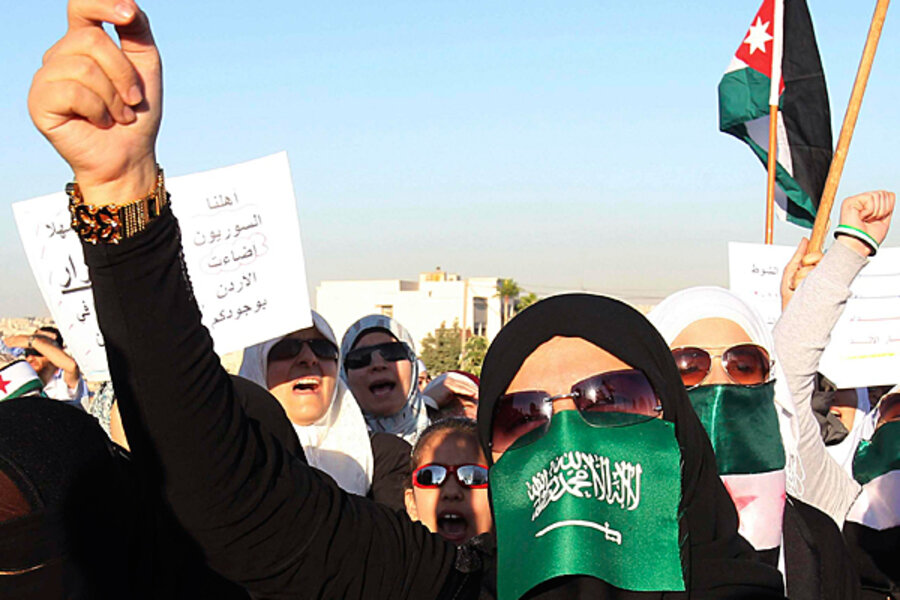Syrian refugees flood Jordan, straining resources
Loading...
| Amman, Jordan
For months, Jordan has been struggling with a steady influx of refugees from Syria, but the latest surge in the violence there may have pushed the small desert kingdom’s capacity to the breaking point.
On Monday night nearly 1,000 Syrians sneaked across Jordan’s northern border with assistance from the Free Syrian Army, according to officials at the UN Refugee Agency (UNHCR). On Tuesday night, there were 790 more. And last night, officials estimate there were 639.
In short, the trickle of refugees from the Syrian civil war into Jordan is turning into a torrent. For the past two months, nightly refugee arrivals had ranged from 50 to 300 people. The growing influx is straining the ability of Jordanian government and international aid agencies to help, and is a reminder that the Syrian war is reverberating far beyond its own borders.
During the Iraq war, hundreds of thousands of Iraqi refugees flooded into Jordan. Jordan has a long history of dealing with refugee crises, notably waves of Palestinians and Iraqis. The international community has always supported the kingdom in providing services to those who used the country as a safe haven in a turbulent region. But today, that support is running thin.
“Hopefully it’s a spike and it goes back down, but what we don’t know is how many thousands of people are coming behind this group,” says Andrew Harper, UNHCR’s representative in Jordan. “Are we prepared to accept 1,000 people coming through a night?”
The transit centers that Jordan has set up for the refugees are completely overwhelmed. The main center, Bashabsheh, is a small complex of buildings and shipping containers on the edge of the Jordanian town of Ramtha. It is bleak and crowded even at its recommended capacity of about 500 people. This week, Mr. Harper says, it is crammed with between 2,500 and 1,4000 and UNHCR and other aid agencies are working full-tilt just to provide the new arrivals with food, water and blankets.
“The current situation is not sustainable,” Harper says. “We need to be thinking much bigger than we are at the moment.” UNHCR is working with the Jordanian government to select another, much bigger site to house new arrivals, and hopes to have one soon.
But it is not yet clear what form the new facility will take. So far, most of the refugees who have made it over the border have not been sequestered in camps, but are held temporarily in transit centers like Bashabsheh, until they can find a Jordanian sponsor who will take legal responsibility for them. Generally, this process takes hours or days, though some families without connections can end up waiting longer. Once out, refugees have been renting houses or staying with local families. The Jordanian government has allowed those who register with UNHCR to use public health facilities, and send their children to public schools. Many families have been assisted by local, primarily Islamic charity organizations. But the new influx is straining this situation.
Financial strains
“If all the transit facilities are full, we may not have any choice but to put all new arrivals into a new camp. And ideally we would like to have those people leave as soon as they can … but as the coping mechanisms of all the communities in Jordan become more limited, we cannot expect them to cope anymore,” Harper says.
Beyond the current emergency, aid officials worry about the Jordanian government’s ability to continue to provide services. Staffing transit camps and offering schooling and health care to refugees is putting a growing strain on the kingdom’s budget. At the end of this school year in June there were 7,300 Syrian children registered to attend Jordan’s public schools, says UNICEF representative Dominique Hyde. And she expects that number to grow as well.
Over the past year, Hyde says, “families were reluctant to put their children in school, because they were all hoping that the situation would abate, and they could return [to Syria]. As the situation is not improving, I think we’ll see a huge spike when school opens in September.”
Jordan also subsidizes many basic goods like water, food, and fuel, which are now being consumed by refugees as well as Jordanians. In 2007-2010, when Jordan was faced with a large influx of refugees from Iraq, the international community provided hundreds of millions of dollars in aid to support the government. But today, even as the kingdom faces one of the worst budget crises in its history, money has not been forthcoming, either for the government or aid agencies.
In March, the UN asked donors for about $84 million for Syrian refugees, $40 million of which was for Jordan. Little of that funding has come through—perhaps only 15 or 20 percent, Harper said. For months, agency representatives have scrambled to provide even limited services, working day-to-day and spending funds as soon as they come in. Last Friday, the UN more than doubled its appeal, asking for nearly $110 million for the region – and that was before the latest surge.
“I’ve got $23 million worth of needs, and I’ve only got $6 million to use, " Harper said. “The response has been very slow. … If [in the future] the Jordanians do have a less generous approach to the Syrian refugees coming in, there’s no one to blame but the international community. Jordan has done the right thing by opening the border … but the resources have not been forthcoming. … Every day that we have the border open is a victory. Every day that Syrian children are in Jordanian schools is a victory. But [Jordan] can’t keep doing this without support.”
This story was updated after its initial posting with the latest data on refugee arrivals from the UNHCR.





